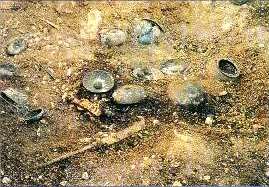|
Near the village of Bayindir in the Elmali plain in northern Lycia are a total of over 100 tumulus burials. A few of these were investigated by a team from the Antalya Museum, beginning in 1987. The excavations were concentrated on two of the tumuli in particular, Tumulus C and Tumulus D, which display different burial customs, cremation and inhumation respectively.
|

In-situ contents of Bayindir tumulus D
|

Ivory figurine of a priest, Tumulus D
|
The general nature of these tumuli is similar to what is known about Phrygian burial customs at Gordion. The Bayindir burials were in pits sunk into the hardpan, and the chambers were constructed of timber The wooden chambers were packed around and above with rubble. Unfortunately, the excessive weight of the stone had caused the roofs to collapse, and the timber structural elements of the chambers had virtually disintegrated. Excavation revealed post-holes for the supports of the wooden roofs.
Both Tumulus C and Tumulus D yielded similar material, much of which is Phrygian in character. That at least two of the vessels may have been imports, or donated by resident Phrygians, is borne out by their Phrygian graffiti. Comparative evidence for the contents as a whole implies an early 7th century date for these two burials.
|
The deceased who was laid to rest on a wooden bed in the north part of Tumulus D has been identified as a female. She was perhaps buried wearing at least one of the two silver belts which were found in the same part of the chamber, and on her chest lay ten bronze fibulae. Nine silver fibulae were found near her head. The other tomb deposits included small cauldrons made of silver and bronze, with either T-shaped attachments and ring handles, or bull's head attachments. Also found were bronze griffin protomes which would have served as cauldron attachments, silver and bronze ladles, silver and bronze omphalos bowls, both plain and petalled, and bowls with rim bands and swivelling ring handles attached to bolsters. There were also several silver decorative plaques, and two iron horse-bits.
The unmistakable Phrygian affinities, with numerous parallels from Gordion, suggest a marked Phrygian influence in the Elmali plain during the 7th century BC. Some of the small finds do, however, find parallels among the foundation deposits of the Artemision at Ephesos and with objects found in Lydian contexts.
Among the small finds in Tumulus D were four figurines, three of ivory and one of silver The silver figurine perhaps represents a priest. The three ivory figurines each have a rectangular hole in the top of the head, and they may have functioned as the stands for perrirhanteria. The four figurines are important in providing comparanda for the study of Anatolian garments, and the exquisite carving of the ivory was quite possibly the work of Lydian ivory workers.
|

Silver figurine of a priest, Tumulus D
|

A group of silver objects from tumulus D
|
Some items from the Bayindir tumuli present parallels to the Usak-Gure jewellery, including silver acorn pendants, animal figurines, boat-shaped earrings, and an ornament with 'double-axe' motifs.
|
|











